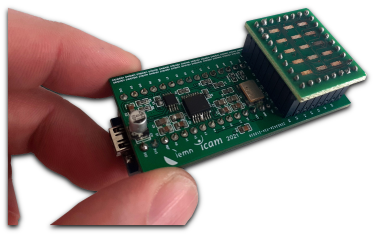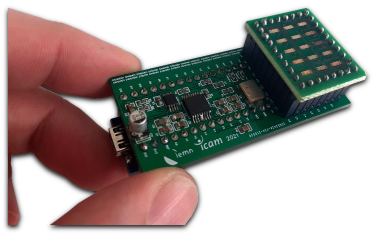









Abstract: Advances on System-On-Chip and organic sensors allows the development of miniaturized impedance measurement hardware for gas monitoring in IoT. In this work, we present the development of miniaturized, multiplexed, and connected platform for impedance sp ectroscopy. Designed for online measurements and adapted to wireless network architectures, our platform has been tested and optimized to be used for multi-selective chemical organic sensor nodes. Our designed circuit is built from low cost and low power consumption microelectronics components providing real time acquisition. The proposed system is based on ESP32 Microcontroller enabling the management of an impedance network analyzer AD5933 (Analog Devices, Norwood, MA, USA) through its I2C interface. Our system benefits from two multiplexer components allowing calibration process and the interface of 15 conductimetric sensors with fast acquisition (less than 90 ms per acquisition). The paper describes the microelectronics design, the impedance respon se over time, the measurement's sensitivity and accuracy and the testing of the platform with embedded chemical sensors for gas classification and recognition.
Routier L., Westrelin A., Cerveaux A., Foulon P., Louis G., Horlac'h T., Lmimouni K., Pecqueur S., Hafsi B.

Abstract: Contributions of organic semiconducting materials to electronics are particularly hard to assess: As macromolecular organizations, they have low enthalpy so they can be processed in soft conditions and they have resilience to deformation. However, for th e same reason, they have also broader density of energy states and more instabilities than silicon in ambient. Controlling matter's order at low scale and its properties for as long as possible were always golden standards for microelectronics. Neverthel ess, in a time where brain functioning rises even more as a source of inspiration, shall it still be so? Here are presented clues on how physical property dispersions may be relevant features for information generator nodes to recognize patterns. In a co ntext where the information to recognize is not trivial to physically define, no model can rule sensors' classification a priori. Despite this, broadening the conducting polymer temporal responses in a sensing array allows recognizing dynamical voltage p atterns, or broadening conducting polymer's chemistry in a sensing array enlarges a classifier's perception field to recognize solvent vapors in air. By the nature of property dispersions in regards to the information to recognize, physical variabilities (structural and chemical) can be assets to exploit for pattern recognition and not necessarily drawbacks to bypass for hardware manufacturing. The brain architecture is also transient: a part of the processed information is engraved in its topology, sho wing that a hardware classifier can make use of physical instabilities as part of its programing, by forming new connections in a nodal architecture. Some evidences are also presented here, on how dendritic morphogenesis of a conducting polymer can be a mean to store past voltage experiences in the impedance between nodes in a topology. Very distinct electrochemical features appear in the readout impedance information after growth and these features are to be associated with the shape of a voltage wave inputted on the junction. By the physical implementation of materials' disorder and transience in electronics devices, it is expected that organic semiconductors will integrate essential ingredients in future-emerging information generator nodes beyond s ensors: from embedded random information generating resources to evolving abilities in information classification architectures.
Pecqueur S., Baron A., Scholaert C., Toledo Nauto M., Moustiez P., Routier L., Guérin D., Lmimouni K., Coffinier Y., Hafsi B., Alibart F.


 Abstract: Advances on System-On-Chip and organic sensors allows the development of miniaturized impedance measurement hardware for gas monitoring in IoT. In this work, we present the development of miniaturized, multiplexed, and connected platform for impedance sp ectroscopy. Designed for online measurements and adapted to wireless network architectures, our platform has been tested and optimized to be used for multi-selective chemical organic sensor nodes. Our designed circuit is built from low cost and low power consumption (250 mW) microelectronics components that achieve long duration operability (5 days and 16 HRS) without compromising on sensor measurement accuracy and precision. We used the well-known impedance network analyzer AD5933 (Analog Devices, Norw ood, MA, USA) chip which can measure a spectrum of impedances in the range 5 Hz to 100 kHz. The proposed system is based on ESP32-C3 Microcontroller enabling the management of the AD5933 through its I2C interface. Our system benefits from two multiplexer components CD74HC4067 allowing calibration process and the interface of 15 conductimetric sensors with real time acquisition (less than 90 ms per acquisition). The system is capable of relaying information through the network for data analysis and stora ge. The paper describes the microelectronics design, the impedance response over time, the measurement's sensitivity and accuracy and the testing of the platform with embedded chemical sensors for gas classification and recognition.
Abstract: Advances on System-On-Chip and organic sensors allows the development of miniaturized impedance measurement hardware for gas monitoring in IoT. In this work, we present the development of miniaturized, multiplexed, and connected platform for impedance sp ectroscopy. Designed for online measurements and adapted to wireless network architectures, our platform has been tested and optimized to be used for multi-selective chemical organic sensor nodes. Our designed circuit is built from low cost and low power consumption (250 mW) microelectronics components that achieve long duration operability (5 days and 16 HRS) without compromising on sensor measurement accuracy and precision. We used the well-known impedance network analyzer AD5933 (Analog Devices, Norw ood, MA, USA) chip which can measure a spectrum of impedances in the range 5 Hz to 100 kHz. The proposed system is based on ESP32-C3 Microcontroller enabling the management of the AD5933 through its I2C interface. Our system benefits from two multiplexer components CD74HC4067 allowing calibration process and the interface of 15 conductimetric sensors with real time acquisition (less than 90 ms per acquisition). The system is capable of relaying information through the network for data analysis and stora ge. The paper describes the microelectronics design, the impedance response over time, the measurement's sensitivity and accuracy and the testing of the platform with embedded chemical sensors for gas classification and recognition.
Routier L., Westrelin A., Cerveaux A., Louis G., Horlac'h T., Foulon P., Lmimouni K., Pecqueur S., Hafsi B.*

 Abstract: Advances on System-On-Chip and organic sensors allows the development of miniaturized impedance measurement hardware for gas monitoring in IoT. In this work, we present the development of miniaturized, multiplexed, and connected platform for impedance sp ectroscopy. Designed for online measurements and adapted to wireless network architectures, our platform has been tested and optimized to be used for multi-selective chemical organic sensor nodes. Our designed circuit is built from low cost and low power consumption microelectronics components providing real time acquisition. The proposed system is based on ESP32 Microcontroller enabling the management of an impedance network analyzer AD5933 (Analog Devices, Norwood, MA, USA) through its I2C interface. Our system benefits from two multiplexer components allowing calibration process and the interface of 15 conductimetric sensors with fast acquisition (less than 90 ms per acquisition). The paper describes the microelectronics design, the impedance respon se over time, the measurement's sensitivity and accuracy and the testing of the platform with embedded chemical sensors for gas classification and recognition.
Abstract: Advances on System-On-Chip and organic sensors allows the development of miniaturized impedance measurement hardware for gas monitoring in IoT. In this work, we present the development of miniaturized, multiplexed, and connected platform for impedance sp ectroscopy. Designed for online measurements and adapted to wireless network architectures, our platform has been tested and optimized to be used for multi-selective chemical organic sensor nodes. Our designed circuit is built from low cost and low power consumption microelectronics components providing real time acquisition. The proposed system is based on ESP32 Microcontroller enabling the management of an impedance network analyzer AD5933 (Analog Devices, Norwood, MA, USA) through its I2C interface. Our system benefits from two multiplexer components allowing calibration process and the interface of 15 conductimetric sensors with fast acquisition (less than 90 ms per acquisition). The paper describes the microelectronics design, the impedance respon se over time, the measurement's sensitivity and accuracy and the testing of the platform with embedded chemical sensors for gas classification and recognition.
Routier L., Westrelin A., Cerveaux A., Foulon P., Louis G., Horlac'h T., Lmimouni K., Pecqueur S., Hafsi B.*
© 2019-2025 Sébastien Pecqueur